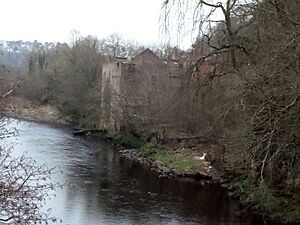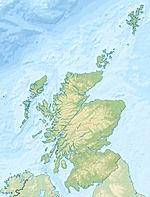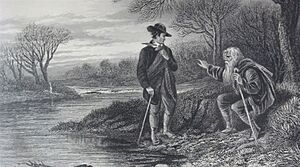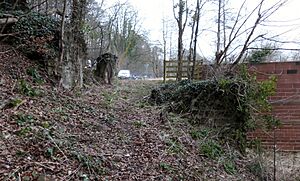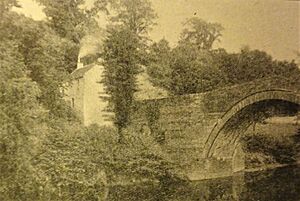Kate Kemp facts for kids
Quick facts for kids
Kate Kemp
|
|
|---|---|
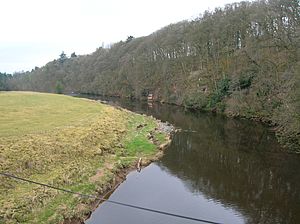
The Miller's Holm from Bridge House
|
|
| Born | Circa 1760 Ayrshire
|
| Occupation | Dairymaid and carer |
Kate Kemp lived with her father at the Bridge House in Barskimming, Scotland. This house was right next to the Barskimming Old Bridge over the River Ayr. Two famous men, the poet Robert Burns and James Andrew (who was the miller at Barskimming Mill), were both interested in Kate. One special visit led Robert Burns to write his famous poem, "Man was made to Mourn".
Contents
Kate's Life and Home
Kate Kemp lived in a beautiful, quiet countryside spot at the old Barskimming Bridge. Her home was sometimes called Kemp's House. It was on the north side of the road that went from Mauchline to Stair. Sadly, this house was taken down sometime after 1861.
People described Kate as a "trim trig lass," which means she was a very neat and attractive young woman. She was one of the most popular girls in the area. It was even said that Robert Burns had an "e'e to Kate," meaning he was very interested in her.
Kate lived with her elderly father, who had a slight paralysis and needed two walking sticks. He could sometimes be a bit grumpy because of his illness. One evening, when Robert Burns and James Andrew came to visit, Kate wasn't home. She was out in the fields looking for a cow that had wandered off. This left her two admirers with some time on their hands while they waited for her to return.
Robert Burns and the Famous Poem
One evening, Robert Burns walked from his home at Mossgiel to the Barskimming Bridge House. He hoped to spend time with Kate, who he found very appealing. When he arrived, Kate's worried father explained that one of their cows was lost, and Kate was out searching for it. She had been gone so long that her father was afraid she might be lost too.
Burns decided to take a walk on the nearby field, hoping Kate would return with the cow. It was during this walk that he started to think about the ideas for his poem.
The first part of his poem "Man is Made to Mourn" seems to describe his meeting with Kate's father:
|
While walking, Burns met James Andrew, the miller. They started talking. James asked Burns what he was doing there, and Burns replied he had come to see Kate Kemp. James said he was going to do the same! Burns then told him that Kate and the cow were both lost, and her father was very worried. He suggested they walk together until Kate showed up.
James Andrew was happy to join Burns. At first, they chatted cheerfully. But soon, Burns became very quiet and thoughtful, lost in his own thoughts. After a while, they silently went their separate ways. A few days later, they met again. Burns apologized for being so quiet, but James understood. He guessed that Burns was busy creating a poem in his mind.
Robert then read his new poem to James and even gave him a copy. This is how the famous poem "Man was Made to Mourn" is said to have been created. The field where they walked was filled with lime and chestnut trees at that time.
The Burns family had moved to Mossgiel in March 1784. Robert Burns wrote "Man is Made to Mourn" in 1784, so his visits to Kate Kemp must have happened that year. He met Jean Armour in April 1785, so his interest in Kate might have ended around then.
James Andrew, the miller, was born in 1765. He worked at Barskimming Mill for many years. We don't know if his attempts to court Kate were successful. His family continued to live and work at the mill for generations.
The poem is most famous for its powerful line: "Man's inhumanity to man."
Man was made to mourn: A Dirge
|
Barskimming Old Bridge and Bridge House
Kate's home, the Bridge House, was known locally as Kemp's House during Robert Burns's time. It was a good cottage located at the north end of the Barskimming Old Bridge. The house likely dated back to the 17th century, just like the bridge. It was originally thatched with straw but later had a slate roof. Steps near the house led into the woods, where a path went towards Barskimming House.
It seems Kate's home was built along with the bridge, perhaps as a lodge or a house for collecting tolls. It was built on a strong stone base in a tricky, small space.
An interesting feature nearby is an artificial cave with a door, carved into the red sandstone cliffs. This cave was used as a dairy in 1879. Next to the bridge, on the southern side, was the Bridge or Miller's Holm. This was where people living at Kemp's House kept their cows.
The Barskimming Old Bridge itself often needed repairs. In 1776, it was improved by building a new arch, making it safer and easier to cross.
See also
- Jean Armour
- Alison Begbie or Elizabeth Gebbie
- Nelly Blair
- May Cameron
- Mary Campbell (Highland Mary)
- Jenny Clow
- Nelly Kilpatrick
- Jessie Lewars
- Ann Park
- Peggy Thompson


